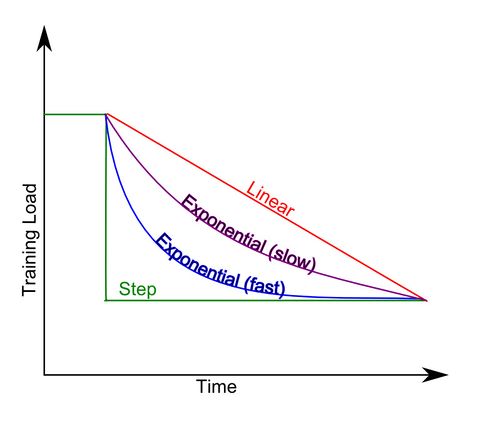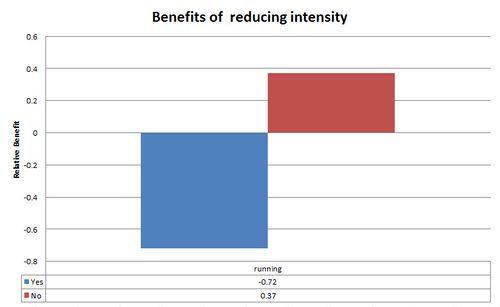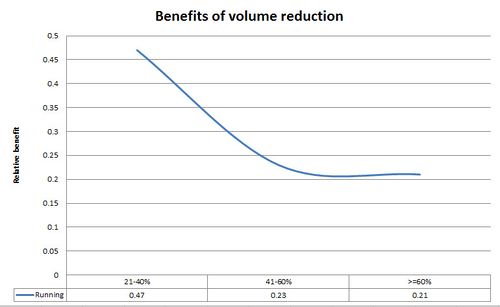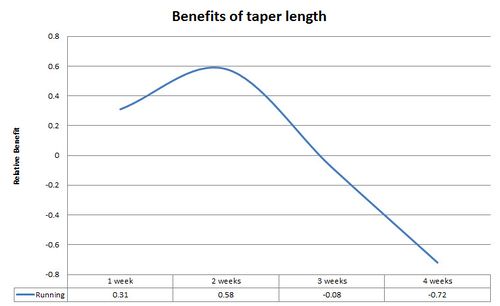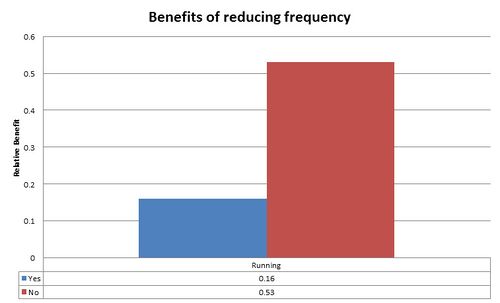Difference between revisions of "Practical Tapering"
User:Mediawiki (User talk:Mediawiki | contribs) |
User:Fellrnr (User talk:Fellrnr | contribs) |
||
| Line 1: | Line 1: | ||
| − | + | Tapering is a critical part of training for a race, but getting the taper right is not simple. | |
| − | + | = General Running Taper = | |
| − | + | The consensus of 27 studies<ref name="Effects of Tapering on Performance: A Meta-Analysis"/> for tapering is listed below. These guidelines are based on studies of relatively short distances, and I found no studies looking at marathon distance or greater. The sections below look at each point in a little more detail, but for more depth, see [[Tapering 101]]. | |
| − | + | * Reduce mileage exponentially | |
| − | |||
| − | |||
| − | The consensus of 27 studies for tapering is listed below | ||
| − | |||
* Do not decrease training intensity (intensity seems to be key) | * Do not decrease training intensity (intensity seems to be key) | ||
| − | * Reduce mileage by 20- | + | * Reduce mileage by 20-40% |
| − | * Taper for 8-14 days | + | * Taper for 8-14 days |
| − | |||
* Keep training frequency the same may be better than reducing frequency. | * Keep training frequency the same may be better than reducing frequency. | ||
| − | + | ==Taper Pattern== | |
| − | == Fellrnr's Personal Approach to Marathon Taper | + | [[File:Taper Patterns2.jpg|none|thumb|500px|Different taper patterns.]] |
| − | The following is my personal advice based on anecdotal and personal experience. This approach works well for a marathon where you are focusing significant resources into an optimal performance. Obviously, running the marathon distance (or greater) does not require a taper, | + | There are a number of well-established patterns for tapering. |
| − | + | * The exponential taper reduces the training load using an exponential pattern and can have a fast or a slow decay. Studies have shown this is the most effective pattern. | |
| + | * A linear pattern reduces the training load by a fixed percentage of the maximum training each day. | ||
| + | * A step taper reduces the training load suddenly, and then keeps it at that level for the length of the taper. This is the least effective pattern. | ||
| + | Below is a table of percentages for a 14 day taper to 40% training load for linear and two exponential tapers. So on day 6, you’d reduce your mileage to 74% on a linear taper, to 68% on a slow exponential taper and to 64% on a fast exponential taper. If you’d run 10 miles in normal training, you’d do 7.4 miles on a linear taper, 6.8 miles on a slow exponential taper and 6.4 miles on a fast exponential taper. | ||
| + | {| {{table}} | ||
| + | | align="center" style="background:#f0f0f0;"|'''Day''' | ||
| + | | align="center" style="background:#f0f0f0;"|'''Linear''' | ||
| + | | align="center" style="background:#f0f0f0;"|'''Exponential (slow)''' | ||
| + | | align="center" style="background:#f0f0f0;"|'''Exponential (fast)''' | ||
| + | |- | ||
| + | | 0||100||100||100 | ||
| + | |- | ||
| + | | 1||96||94||92 | ||
| + | |- | ||
| + | | 2||91||88||86 | ||
| + | |- | ||
| + | | 3||87||82||79 | ||
| + | |- | ||
| + | | 4||83||77||74 | ||
| + | |- | ||
| + | | 5||79||72||69 | ||
| + | |- | ||
| + | | 6||74||68||64 | ||
| + | |- | ||
| + | | 7||70||63||60 | ||
| + | |- | ||
| + | | 8||66||59||56 | ||
| + | |- | ||
| + | | 9||61||55||53 | ||
| + | |- | ||
| + | | 10||57||52||50 | ||
| + | |- | ||
| + | | 11||53||49||47 | ||
| + | |- | ||
| + | | 12||49||46||44 | ||
| + | |- | ||
| + | | 13||44||43||42 | ||
| + | |- | ||
| + | | 14||40||40||40 | ||
| + | |} | ||
| + | ==Training Intensity== | ||
| + | [[File:Taper intensity running.jpg|none|thumb|500px|Reducing intensity for running tapers.]] | ||
| + | The studies show that reducing training intensity during the taper period reduces your performance rather than improving it. | ||
| + | ==Mileage== | ||
| + | [[File:Taper volume running.jpg|none|thumb|500px|Reducing mileage for running tapers.]] | ||
| + | The studies show that for runners, reducing mileage by 20-40% is optimal, though the standard tapers involve reducing by far more. The actual reduction may be dependent on the overall training mileage, with higher mileage runners requiring more of a reduction, though this is not supported by the science. | ||
| + | ==Taper Length== | ||
| + | [[File:Taper length running.jpg|none|thumb|500px|Taper length for running tapers.]] | ||
| + | The studies show that a length of taper of 2 weeks is ideal, and 3 weeks or longer actually produces a slightly negative change in performance compared with no taper. It has been suggested that the ideal length of taper depends on the number of hours per week spent in training, as shown in the table below, but the evidence to support this is anecdotal. | ||
| + | {| {{table}} | ||
| + | | align="center" style="background:#f0f0f0;"|'''Training hours/week''' | ||
| + | | align="center" style="background:#f0f0f0;"|'''Days for taper''' | ||
| + | |- | ||
| + | | 6 to 10||7 | ||
| + | |- | ||
| + | | 11 to 15||14 | ||
| + | |- | ||
| + | | Over 15||21+ | ||
| + | |} | ||
| + | =Training Frequency= | ||
| + | [[File:Taper fequency running.jpg|none|thumb|500px|Reducing mileage for running tapers.]] | ||
| + | The evidence is that keeping the same frequency of training runs during the taper produces a better improvement than reducing the frequency. | ||
| + | = Fellrnr's Personal Approach to Marathon Taper = | ||
| + | The following is my personal advice based on anecdotal and personal experience. This approach works well for a marathon where you are focusing significant resources into an optimal performance. Obviously, running the marathon distance (or greater) does not '''require''' a taper, but performance is optimized by doing one. | ||
* Taper for two weeks | * Taper for two weeks | ||
* Cut out any easy paced/recovery/junk runs (if you are doing any) | * Cut out any easy paced/recovery/junk runs (if you are doing any) | ||
| Line 22: | Line 80: | ||
* Do medium length runs at marathon pace (Running at marathon pace improves your sense of pace and become comfortable at this speed) | * Do medium length runs at marathon pace (Running at marathon pace improves your sense of pace and become comfortable at this speed) | ||
* Do 'easy intervals' - for instance, mile repeats at tempo pace with full recovery. The idea is to be fast enough to keep prevent detraining, but easy enough to avoid any muscle soreness. You could do harder intervals if you are confident they will not cause soreness. | * Do 'easy intervals' - for instance, mile repeats at tempo pace with full recovery. The idea is to be fast enough to keep prevent detraining, but easy enough to avoid any muscle soreness. You could do harder intervals if you are confident they will not cause soreness. | ||
| + | * Ideally, don't do any running at slower than marathon pace. | ||
| − | == Fellrnr's Personal Ultra Tapering | + | = Short Race Tapers = |
| + | For a short race (5K), a study <ref name="The effects of taper on performance in distance runners"/> showed that drastically reducing training volume, while keeping intensity high can produce great gains. A 7 day taper that reduces mileage by 85% and has a decreasing number of hard intervals (7 the first day, 6 the next, etc.) produces good results. However, this type of taper tends to cause muscle soreness, which makes it less than ideal for longer races. | ||
| + | = Fellrnr's Personal Ultra Tapering = | ||
Like many ultrarunners, I do far more races in a year than typical marathon runners. This race load means that a longer taper is impractical. Therefore, for a short ultra (up to 50 miles), I take the day before the race off completely and convert that week's hill training to a flat run. For longer races, I'll reduce my Monday and Wednesday runs to one hour rather than three, avoid hills and take Friday off. (I normally only run Monday, Wednesday, Friday and Saturday.) | Like many ultrarunners, I do far more races in a year than typical marathon runners. This race load means that a longer taper is impractical. Therefore, for a short ultra (up to 50 miles), I take the day before the race off completely and convert that week's hill training to a flat run. For longer races, I'll reduce my Monday and Wednesday runs to one hour rather than three, avoid hills and take Friday off. (I normally only run Monday, Wednesday, Friday and Saturday.) | ||
| − | == | + | =See also= |
| − | [ | + | * [[Golden Rule of Tapering]] |
| − | [ | + | * [[Tapering 101]] |
| + | * [[Tapering Tips]] | ||
| − | + | = References = | |
| − | [http://journals.lww.com/acsm-msse/pages/articleviewer.aspx?year=2007&issue=08000&article=00019&type=abstract http://journals.lww.com/acsm-msse/pages/articleviewer.aspx?year=2007&issue=08000&article=00019&type=abstract] | + | <references> |
| + | <ref name="Effects of Tapering on Performance: A Meta-Analysis">Effects of Tapering on Performance: A Meta-Analysis : Medicine & Science in Sports & Exercise [http://journals.lww.com/acsm-msse/pages/articleviewer.aspx?year=2007&issue=08000&article=00019&type=abstract</ref http://journals.lww.com/acsm-msse/pages/articleviewer.aspx?year=2007&issue=08000&article=00019&type=abstract</ref]> | ||
| + | <ref name="The effects of taper on performance in distance runners">The effects of taper on performance in distance runners http://cat.inist.fr/?aModele=afficheN&cpsidt=3379866 </ref> | ||
| + | </references> | ||
Revision as of 12:01, 15 October 2011
Tapering is a critical part of training for a race, but getting the taper right is not simple.
Contents
[hide]1 General Running Taper
The consensus of 27 studies[1] for tapering is listed below. These guidelines are based on studies of relatively short distances, and I found no studies looking at marathon distance or greater. The sections below look at each point in a little more detail, but for more depth, see Tapering 101.
- Reduce mileage exponentially
- Do not decrease training intensity (intensity seems to be key)
- Reduce mileage by 20-40%
- Taper for 8-14 days
- Keep training frequency the same may be better than reducing frequency.
1.1 Taper Pattern
There are a number of well-established patterns for tapering.
- The exponential taper reduces the training load using an exponential pattern and can have a fast or a slow decay. Studies have shown this is the most effective pattern.
- A linear pattern reduces the training load by a fixed percentage of the maximum training each day.
- A step taper reduces the training load suddenly, and then keeps it at that level for the length of the taper. This is the least effective pattern.
Below is a table of percentages for a 14 day taper to 40% training load for linear and two exponential tapers. So on day 6, you’d reduce your mileage to 74% on a linear taper, to 68% on a slow exponential taper and to 64% on a fast exponential taper. If you’d run 10 miles in normal training, you’d do 7.4 miles on a linear taper, 6.8 miles on a slow exponential taper and 6.4 miles on a fast exponential taper.
| Day | Linear | Exponential (slow) | Exponential (fast) |
| 0 | 100 | 100 | 100 |
| 1 | 96 | 94 | 92 |
| 2 | 91 | 88 | 86 |
| 3 | 87 | 82 | 79 |
| 4 | 83 | 77 | 74 |
| 5 | 79 | 72 | 69 |
| 6 | 74 | 68 | 64 |
| 7 | 70 | 63 | 60 |
| 8 | 66 | 59 | 56 |
| 9 | 61 | 55 | 53 |
| 10 | 57 | 52 | 50 |
| 11 | 53 | 49 | 47 |
| 12 | 49 | 46 | 44 |
| 13 | 44 | 43 | 42 |
| 14 | 40 | 40 | 40 |
1.2 Training Intensity
The studies show that reducing training intensity during the taper period reduces your performance rather than improving it.
1.3 Mileage
The studies show that for runners, reducing mileage by 20-40% is optimal, though the standard tapers involve reducing by far more. The actual reduction may be dependent on the overall training mileage, with higher mileage runners requiring more of a reduction, though this is not supported by the science.
1.4 Taper Length
The studies show that a length of taper of 2 weeks is ideal, and 3 weeks or longer actually produces a slightly negative change in performance compared with no taper. It has been suggested that the ideal length of taper depends on the number of hours per week spent in training, as shown in the table below, but the evidence to support this is anecdotal.
| Training hours/week | Days for taper |
| 6 to 10 | 7 |
| 11 to 15 | 14 |
| Over 15 | 21+ |
2 Training Frequency
The evidence is that keeping the same frequency of training runs during the taper produces a better improvement than reducing the frequency.
3 Fellrnr's Personal Approach to Marathon Taper
The following is my personal advice based on anecdotal and personal experience. This approach works well for a marathon where you are focusing significant resources into an optimal performance. Obviously, running the marathon distance (or greater) does not require a taper, but performance is optimized by doing one.
- Taper for two weeks
- Cut out any easy paced/recovery/junk runs (if you are doing any)
- Have the last long run at the beginning of the taper. No run past this point should have the purpose of improving endurance.
- Avoid hard downhill running in the taper
- Do medium length runs at marathon pace (Running at marathon pace improves your sense of pace and become comfortable at this speed)
- Do 'easy intervals' - for instance, mile repeats at tempo pace with full recovery. The idea is to be fast enough to keep prevent detraining, but easy enough to avoid any muscle soreness. You could do harder intervals if you are confident they will not cause soreness.
- Ideally, don't do any running at slower than marathon pace.
4 Short Race Tapers
For a short race (5K), a study [2] showed that drastically reducing training volume, while keeping intensity high can produce great gains. A 7 day taper that reduces mileage by 85% and has a decreasing number of hard intervals (7 the first day, 6 the next, etc.) produces good results. However, this type of taper tends to cause muscle soreness, which makes it less than ideal for longer races.
5 Fellrnr's Personal Ultra Tapering
Like many ultrarunners, I do far more races in a year than typical marathon runners. This race load means that a longer taper is impractical. Therefore, for a short ultra (up to 50 miles), I take the day before the race off completely and convert that week's hill training to a flat run. For longer races, I'll reduce my Monday and Wednesday runs to one hour rather than three, avoid hills and take Friday off. (I normally only run Monday, Wednesday, Friday and Saturday.)
6 See also
7 References
- Jump up ↑ Effects of Tapering on Performance: A Meta-Analysis : Medicine & Science in Sports & Exercise </ref http://journals.lww.com/acsm-msse/pages/articleviewer.aspx?year=2007&issue=08000&article=00019&type=abstract</ref> <ref name="The effects of taper on performance in distance runners">The effects of taper on performance in distance runners http://cat.inist.fr/?aModele=afficheN&cpsidt=3379866
- Jump up ↑ Cite error: Invalid
<ref>tag; no text was provided for refs namedThe_effects_of_taper_on_performance_in_distance_runners
- Category:Pages with reference errors
